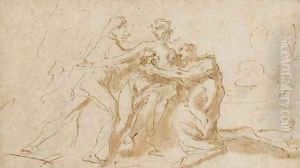Giovanni Battista Pellegrini Paintings
Giovanni Battista Pellegrini was an Italian painter, primarily of the late Baroque and Rococo periods. Born in 1675 in Venice, Italy, he was part of the rich and vibrant artistic atmosphere of the city that was home to many great artists of the time. Pellegrini's work was influenced by the grand tradition of Venetian painting, and he is often associated with the transition from the Baroque to the Rococo style in Italian art.
Pellegrini began his artistic training under the guidance of Antonio Balestra, who was a prominent painter in Venice. Early on in his career, Pellegrini's talent was recognized, and he became known for his ability to blend the dynamic qualities of the Baroque with the emerging lighter, more decorative elements of the Rococo. His style was characterized by his use of vibrant colors, elegant figures, and a sense of movement within his compositions.
Throughout his career, Pellegrini traveled extensively, which allowed him to absorb various artistic influences and expand his repertoire. He worked in various cities across Europe, including Düsseldorf, London, and Paris, receiving commissions from notable patrons and contributing to the spread of Venetian style across the continent. Among his well-known works were frescoes and altar pieces for churches, as well as mythological and historical paintings for the palaces of the European elite.
Pellegrini's work was well-received in his time, and he was considered one of the leading Venetian painters of his generation. His ability to adapt to different artistic environments and his proficiency in large-scale decorative schemes made him a sought-after artist among the aristocracy. Despite his success, Pellegrini's work was later overshadowed by the more famous Venetian painters of the 18th century, such as Giambattista Tiepolo.
Giovanni Battista Pellegrini's legacy within the art world is notable for his contribution to the development of the Rococo in Venice and beyond. His paintings still can be seen in various churches and palaces throughout Europe, and they continue to be studied for their artistic and historical significance. Pellegrini passed away in 1741 in Venice, leaving behind a body of work that encapsulates the transition between two significant artistic periods in European art history.
